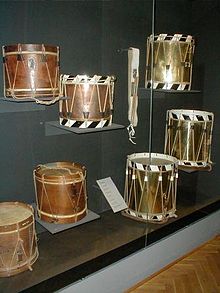Basel drum
The Basel drum is a two- skin drum . The percussion instrument takes its name from its use in Basel customs (e.g. Basel Carnival ). The drum players are called tambours , with several tambours usually forming a drum group for use in marching music .
Drums of the same design are used throughout Switzerland in drum and piper clubs as well as in Swiss military music as the Swiss drum or orderly 82 .
Construction
Until the late 18th century, drums were mainly made of wood, but brass frames have been found in Prussia since the early 18th century . In the 19th century copper, tinplate and nickel silver were also used. Today the frame is mostly made of chrome-plated brass. In addition, you can also see frames made of non-chrome-plated brass, aluminum (weight advantage) and, more recently, even made of carbon fiber. For some time now, wooden drums have been used more and more, not only because of their appearance, but above all because of their much lower weight. In addition, the drier sound of the wooden drum is perceived as more pleasant by many tambours.
The tires of the metal drums are usually black and white (diagonally) striped, corresponding to the colors of the Basel coat of arms . (In other cantons, different colors are used, the Swiss Army uses red and white tires. Colors from guilds or family crests are only rarely used today.) The tires of the wooden drums are mostly left in their natural color. While the color scheme used to strictly obey the heraldry and an exception was only tolerated for wooden drums, today whatever you like is allowed. Chrome-plated frames with black and white tires and black or white stripes continue to dominate the picture.
Two skins are stretched over the two open ends of the frame (also called "Kessel" or "Kübel" in Basel). These are made of plastic or calf skin parchment, with calf skins being more comfortable to play on because of their soft spring back. However, natural skins can only be used in dry weather, otherwise they will become limp. A drum covered with calfskin therefore requires in practice the possession of a second drum with plastic skin.
The drum heads are held together under tension by the drum rope, which is made of plastic or hemp (in the second case today with a carbon core to minimize weather-related fluctuations in tension) and which runs through holes in the two tires, and is toned. In earlier times the rope was simply looped around the tire or attached to it with iron hooks. In order to tension the ropes, the tires are pressed against each other in a block. Then the rope is tightened all around, again and again, until all sections are about the same tension. Before you 'relax' the drum again, the protruding end of the rope, which is pulled through a loop at the beginning, is turned into a so-called 'snail'. The excess rope is attached to the lower tire.
The drum owes its rattling sound to the eight drum strings (snare strings) made of gut or plastic, mostly in combination with metal strings, which run over the lower skin (resonance skin or string skin). The top head (batter head) is dampened by a damper to prevent the drum from reverberating ("singing").
The diameter of a Basel drum is measured on the outside of the frame and is usually 40 or 41 cm, occasionally 42 or even 43 cm. A larger diameter leads to a fuller sound, but makes the drum more maintenance-intensive, especially if it is covered with natural skins. The height of the frame usually corresponds to the diameter.
history
The oldest surviving drum of this type dates from 1571. It is in the Basel Music Museum . Swiss customs and ecclesiastical festivals such as B. Carnival, guild life and public events with dance, games and entertainment were mostly accompanied by the sounds of drums.
Marching drums in Europe and in the colonies were generally of this type until the 19th century. Accordingly, such drums are always z. B. to be seen in Wild West films that take place during the American Civil War. Such drums are also commonly used for performances by groups dedicated to the music of that time. The advancement of the marching drum then went in the direction that around the beginning of the 19th century the ropes were replaced by a tensioning mechanism with metal screws and the frame became shorter and shorter. The Basel drum stayed with the old design.
Style of play
The drum is always at an angle in front of the tambour. Since the holder of the drum is on the left side (Bandalier; the wide leather strap that is worn over the shoulder), it therefore runs from the top right to the bottom left. (Seen from the point of view of the drum)
To play the drum, the tambours hold two (wooden) mallets in their hands. The right hand completely encloses the mallet and holds it at an angle (so that the hand is in line with the forearm). The mallet is held on the left hand with the index, middle and thumb and lies on the ring finger.



